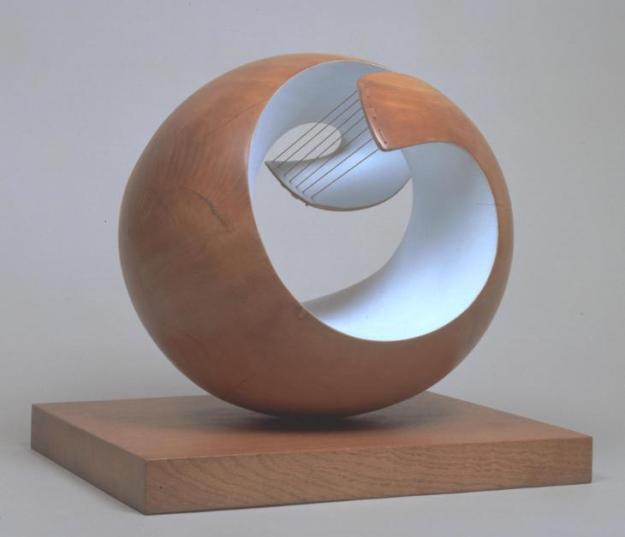This morning I jumped on a train and went to see the Barbara Hepworth exhibition at Tate Britain. Barbara Hepworth is an artist that I admire. She was a woman who didn’t let her gender interfere with what she was trying to do, who went her own way and who produced incredibly elegant, spare sculpture. Her preoccupations were with the human figure and landscape and the relationship between the two. I am especially interested in the way her work reflects a physical response to the environment, ‘feeling, touching, seeing through mind and hand and eye’. (extract from Barbara Hepworth, A Pictorial Autobiography, Bath, 1971).
I’ve seen Hepworth sculptures many times before but today I wanted to look at the relationship between her forms and the space around (and inside) them – the holes. I made some notes about the things that particularly caught my eye. They are rather disjointed, but I thought I‘d record them here as I wrote them down in my notebook.
Small Sculpture
Squint/ peer – looking through holes and tunnels to the other side. Cups and depressions are almost holes.
Placement
Positioning and display – the base is part of the sculpture
Discs in Echelon
Placed close together on a base. The space between the two parts is very close – the gap is almost a hole. Although not fully enclosed the space appears to be so as the two elements seem to be one.

Discs in Echelon 1935, cast 1959 Dame Barbara Hepworth 1903-1975 Presented by the executors of the artist’s estate 1980 http://www.tate.org.uk/art/work/T03132
Forms in Echelon 1938
Look through the hole/tunnel. Offset behind, to show left edge only – smooth, shiny, rich.

Forms in Echelon 1938 Dame Barbara Hepworth 1903-1975 Presented by the artist 1964 http://www.tate.org.uk/art/work/T00698
Pendour
Many holes – large and small on top and all sides. Interior space painted white and surprisingly pale blue. Shadows.
http://barbarahepworth.org.uk/sculptures/1947/pendour/
Pelagos
Strings disrupt the interior space. Shadows disrupt the interior space.

Pelagos 1946 Dame Barbara Hepworth 1903-1975 Presented by the artist 1964 http://www.tate.org.uk/art/work/T00699
Oval sculpture
The amount of wood taken away makes the heaviness fragile and skeletal – an irregular honeycomb.
Curved Form (Trevalgan)
A hole within an almost hole. Cupped – slung –rigid tops.

Curved Form (Trevalgan) 1956 Dame Barbara Hepworth 1903-1975 Purchased 1960 http://www.tate.org.uk/art/work/T00353
Jeanette Winterson sums up in this article.
‘Hepworth wanted to see right through solid form, but what happened was a surprise. By surrounding space with form, the invisible becomes visible. Here was a view previously enjoyed only by God: nothingness.
Sometimes I think that Hepworth’s pierced forms are inversions. That the object, however beautiful, is a means of seeing the empty space within and around it.’
I really enjoyed this exhibition and I will have to go back. It is very hard not to touch these remarkable sculptures – to put out your hand and stroke the smooth shiny surfaces of wood and stone or to put your fingers into and through the visible nothingness of the holes.



The space between two or more forms is also a hole
Fantastic work. Really honest words
Helen x